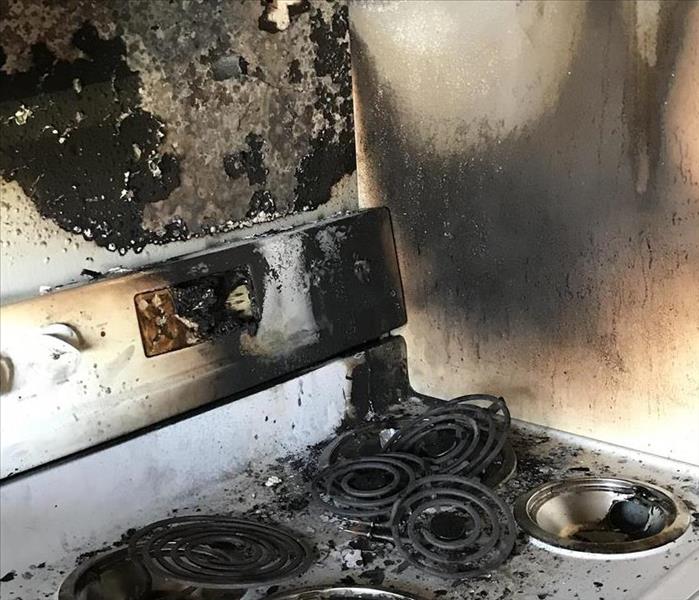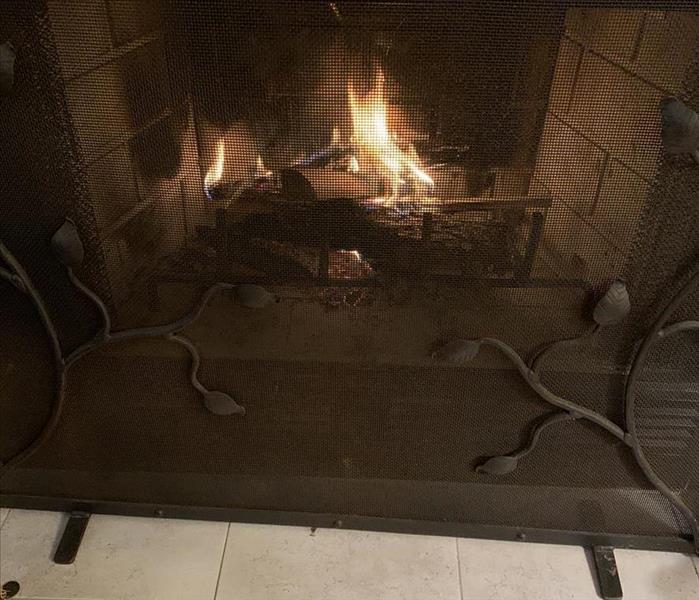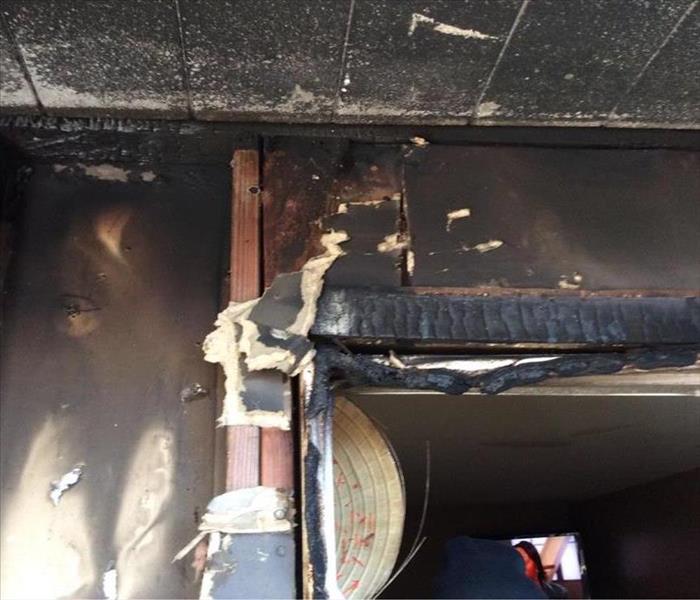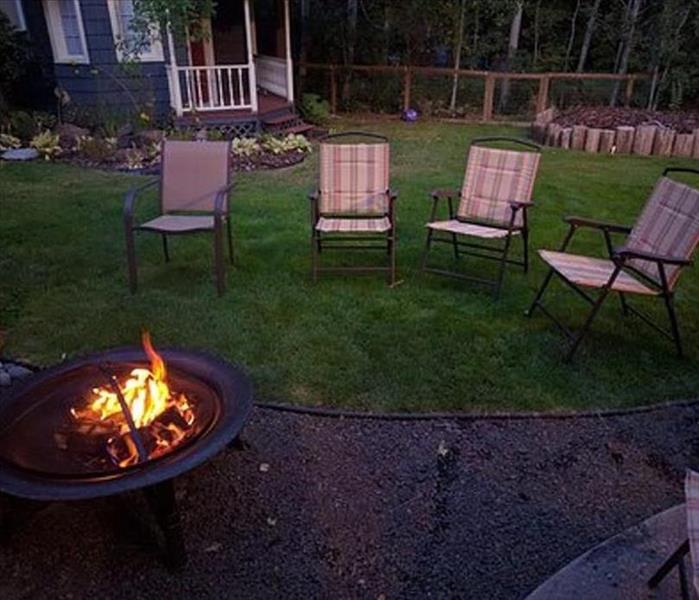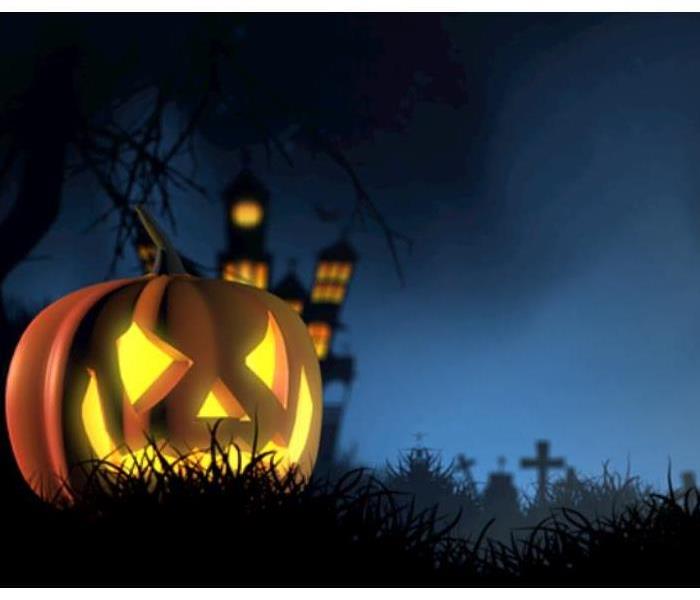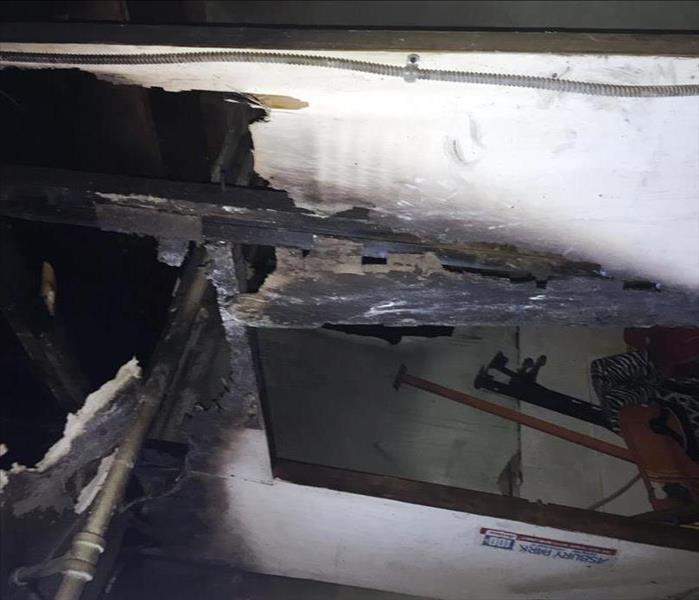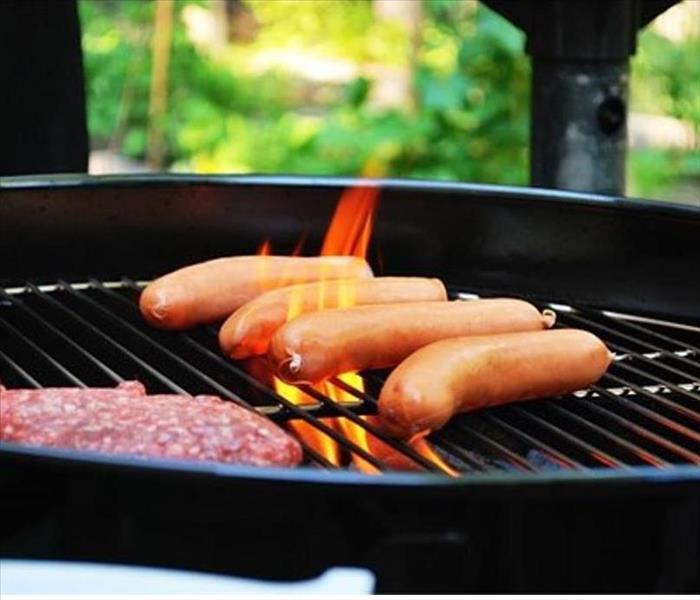Recent Fire Damage Posts
How to use a Fire Extinguisher
3/31/2022 (Permalink)
 A close-up look at a fire extinguisher handle.
A close-up look at a fire extinguisher handle.
In a prior blog, we discussed the acronym R.A.C.E. which represents the steps to take in care of a fire. Those steps are Rescue, Alarm, Contain, and Extinguish. Another acronym used in training for a fire response is P.A.S.S. which stands for Pull, Aim, Squeeze, and Sweep. These are the steps for using a fire extinguisher.
First, you want to make sure you have the correct fire extinguisher. In most settings, an ABC class extinguisher is most common. An ABC extinguisher puts out most fires including:
Class A fires – common materials including wood which typically produce Ashes.
Class B fires – flammable liquids that are typically stored in a Barrel, such as gasoline.
Class C fires – electrical fires that have an electrical Current
Fires that require a more specialized type of extinguisher include class D fires which are flammable metal or class K fires which are high temperature cooking oil fires.
The steps for using a fire extinguisher are:
P: Pull the pin that prevents the extinguisher from discharging accidentally.
A: Aim the nozzle at the base of the fire
S: Squeeze the handle/trigger to discharge the extinguishing agent
S: Sweep the nozzle back and forth to cover the burning material
What to do in case of a fire
3/30/2022 (Permalink)
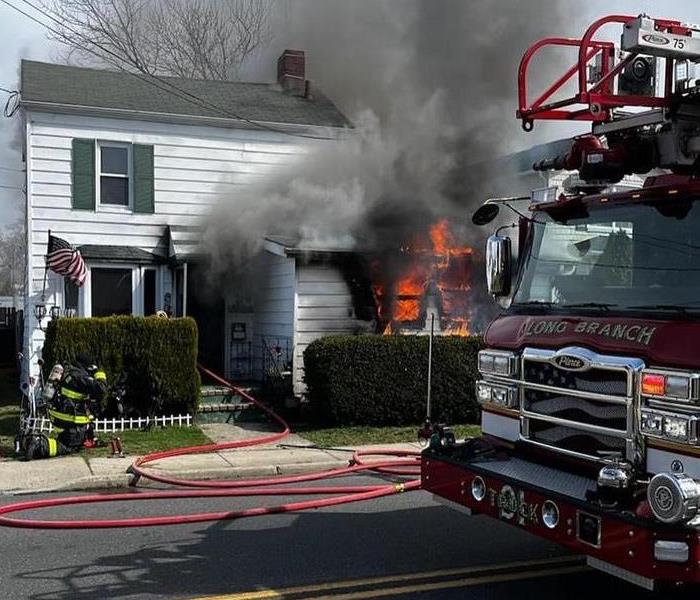 The Long Branch, NJ fire department fights a house fire on Patten Ave., March 28, 2022.
The Long Branch, NJ fire department fights a house fire on Patten Ave., March 28, 2022.
What should you do if you encounter a fire in your home or business? The common acronym R.A.C.E. provides some helpful guidelines. This stands for Rescue, Alarm, Contain, and Extinguish. These are the priority actions that should be taken. Unfortunately, they are often not followed in a panic as people typically try to fight the fire themselves, which costs precious time.
Rescue – The priority is life safety. Smoke and other deadly products of combustion can incapacitate an individual with just a few breaths. The top priority is rescuing anyone who is in personal danger.
Alarm – Sound the alarm by hitting the fire button on your alarm system or calling 911. A fire doubles in size every 45 seconds so alerting the fire department to begin their response is your second priority.
Contain – Stopping the spread of the fire is even more important than trying to extinguish the fire. Closing doors is a simple and effective way of stabilizing the scene and limiting fire spread. Moving a car away from a burning shed or using a garden hose to spray the vinyl siding next to a grill fire can likewise stop the fire from spreading and causing significantly more damage. All of these actions should only be attempted if they can be done safely.
Extinguish – Only after the first three actions have been completed should you attempt to extinguish the fire. Again, only if it can be done safely. Keep in mind that different types of fires (electrical, grease, gas-fed) may require special techniques to extinguish. At a minimum, every home and business should have an ABC class fire extinguisher handy as this is the most versatile type of extinguisher.
Of course, once the fire is extinguished, call SERVPRO because a quick response and immediate action can reduce the extent of smoke, water, and other damage.
Fire Prevention in Commercial Spaces
2/28/2022 (Permalink)
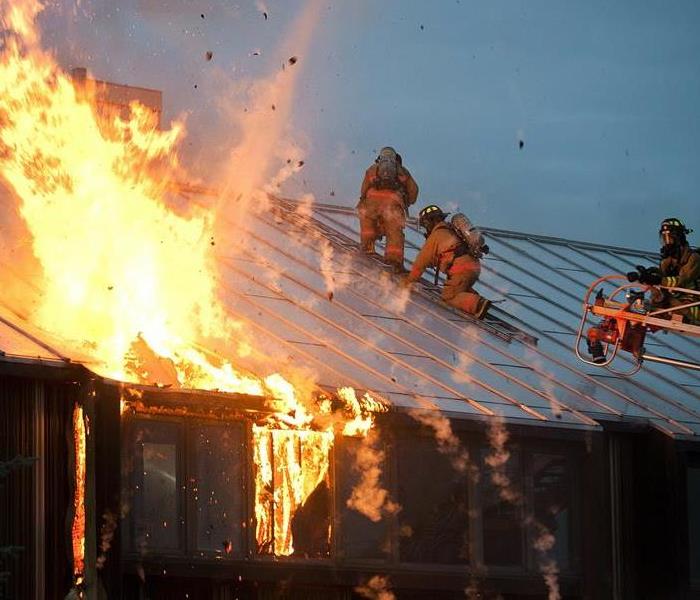 Firefighters working on the roof at a commercial fire.
Firefighters working on the roof at a commercial fire.
Fire Safety in the workplace is important all year round and our team here at SERVPRO of Eatontown/Long Branch would like to review workplace fire prevention & safety.
Here is a top-10 of tips to ensure a fire-safe workplace:
Step 1. Get Organized– Practice good workplace housekeeping. Clutter contributes to fires by providing fuel and by preventing access to exits and emergency equipment.
Step 2. Designated Smoking Areas – Smoke only in designated areas and extinguish smoking materials safely. Never smoke in storerooms or chemical storage areas.
Step 3. Fire Extinguishers – Maintaining the appropriate type and number of fire extinguishers and learning how to properly use a fire extinguisher.
Step 4. Electrical Hazards – Report all electrical hazards. Many fires start in faulty wiring and malfunctioning electrical equipment.
Step 5. Access to Control Panels – Electrical control panels need to have free access maintained so that the electricity could be shut off easily.
Step 6. Sprinkler Systems & Smoke Detectors – Never block sprinklers, firefighting equipment, or emergency exits. Observe clearances when stacking materials. Test sprinkler systems and smoke detectors at least annually.
Step 7. Chemical Safety – Use and store chemicals safely. Read the label and the Safety Data Sheet to determine flammability and other fire hazards. Provide adequate ventilation when using and storing these substances.
Step 8. Waste Control & Storage – Control the accumulations of flammable and combustible waste materials and residues so that they do not contribute to a fire emergency.
Step 9. Exits – Emergency exit diagrams should be posted and emergency exits should be well lit with neon-regulation signs.
Step 10. Contact Info – Employees should have a list of emergency contact phone numbers in case of emergency. Remember that people will often panic in an intense situation; therefore basics such as the company address, phone number, and floor plan should be posted. The SERVPRO Emergency Ready Plan app is a great tool for collecting, storing, and sharing this information.
For additional information or a free consultation, please call us today.
Cleaning Smoke and Soot After a Fire
1/29/2022 (Permalink)
 The mess was left behind after a dryer fire.
The mess was left behind after a dryer fire.
Smoke damage can make your home a dirty, smelling mess. Whether you’ve suffered a major fire catastrophe or had smoke damage accumulate from the presence of fire in your home, you want to start cleaning up smoke stains as soon as you can in order to prevent permanent damage.
Our team at SERVPRO of Eatontown/Long Branch has seen our share of fire incidents as Professional Cleaning and Restoration Leaders in this community so, we know what smoke damage can do to a home.
Make Sure the Area is Safe
If your incident was a small kitchen grease fire, there is probably minimal risk. However, if the fire burned through a significant section of your home, you want to be sure the area you enter is structurally sound and cleared by officials before anyone can attempt to start fixing it.
Dispose of Everything that Can’t Be Salvaged
The first step of the cleaning process is to get rid of everything that can’t be saved.
Be especially wary of food that may have been contaminated, plastics that may have melted, or materials that are too stained to be cleaned.
Vacuum Up Debris
We have specialized equipment to clean up debris.
Soot is greasy, it is best to wait for a professional to clean soot-stained surfaces than make a bigger mess.
Clean up Odors
You can clean some fabric and upholstery yourself that may have avoided smoke stains may still have absorbed odors.
If you have fabrics that are dry clean only, be sure to take them to a dry cleaner that specializes in smoke removal or fire treatment.
For fabrics that can go in a washing machine, add a cup of white vinegar and a cup of baking soda to your regular load to clean the smoke damage. A mixture of white vinegar and baking soda can also be used to spot clean carpeting and upholstery.
Seal Surfaces
Even after a full cleaning, there may still be some lingering stains and odors. To mitigate this, we use a sealing primer.
We use specialized sealers for different surfaces. For example, on painted walls, we use a stain concealing primer followed by a topcoat of latex paint. For wooden surfaces, we use a sealer designed specifically for wood or particleboard.
If you need professional assistance in cleaning up after a fire incident, SERVPRO of Eatontown/Long Branch is here to help. Our specialized technicians have the advanced training and equipment needed to clean and restore your property, helping you get your life and property back to normal ASAP.
Fast response to a fire
10/28/2021 (Permalink)
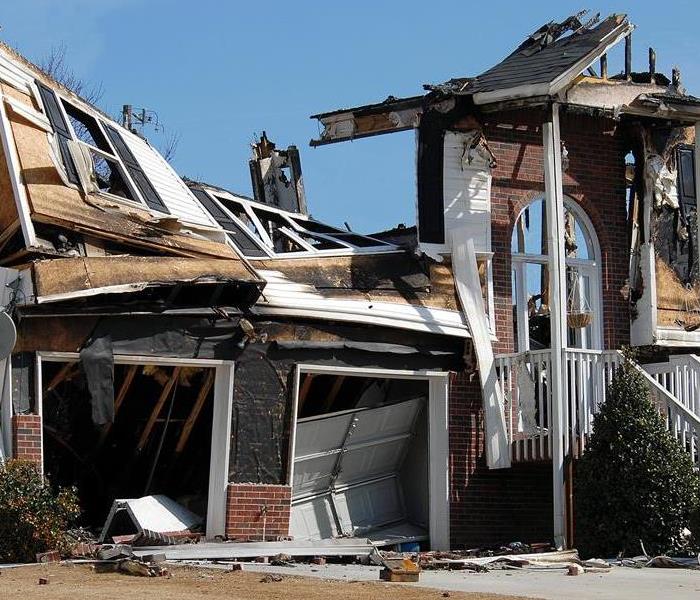 Severely damaged home do to a fire
Severely damaged home do to a fire
When a fire happens you expect a quick response from the fire department. But what happens once the fire is extinguished? The fire department does what they can to minimize damage to "exposure areas" but their responsibility ends once the fire is extinguished.
You will need a restoration company to intervene quickly to minimize damage. To that end, we respond as quickly as possible to be able to assist the owner in navigating the process. This sometimes leads to an awkward situation where owners are confused about why we are there and what they should do. I've personally had people react negatively as they perceive our quick response as a way to make a buck. While I understand this perception, and we are a business, it is our intention to assist the owner through every step of the process in order to minimize damage, provide assurances that things will be returned to normal, and ensure that important first steps are done correctly.
If you see us at a fire scene, please understand that our mission is to assist those affected in a variety of ways and without delay. Please help us to engage with the owner and allow us to use our expertise to be a resource to them. Thank you!
Key First Steps in Fire Damage Remediation
10/28/2021 (Permalink)
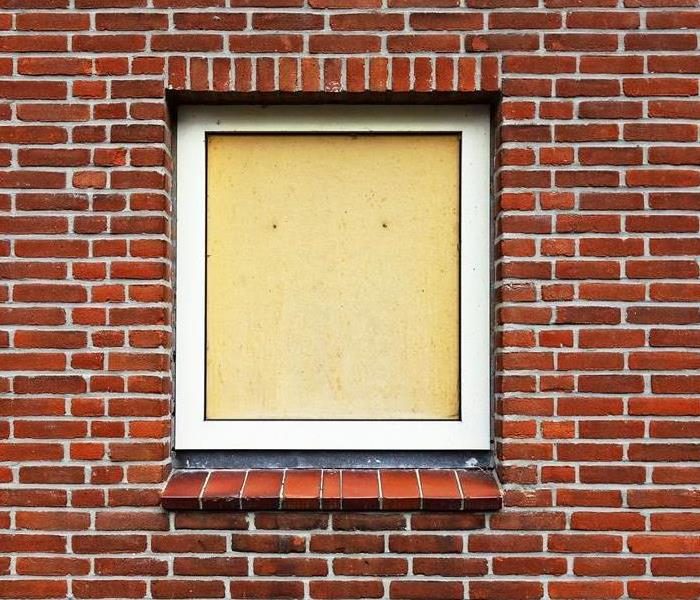 A boarded-up window on a brick home.
A boarded-up window on a brick home.
In a prior post, I spoke about our rapid response to a fire scene and our purpose for being there, often before the fire department leaves. Below I will touch upon some of the critical actions we take when we connect with the owner.
First, we provide assurance that we will be with them throughout the process. This includes facilitating communication between the owner and the insurance company as well as third-party adjusters. We use the same estimating software that is used by insurers to accurately document and detail what services are needed to reduce the possibility that claims will be questioned down the road.
Second, we look to secure the scene. Firefighters may have removed doors and are trained to "turn windows into doorways" as a way to provide both evacuation routes and ventilate the structure. quick board-up is needed to prevent additional damage and prevent unauthorized entry.
Third, we look to identify and remove belongings that need special attention and storage at our offsite facilities. This may include precious items, family heirlooms, and keepsakes.
Forth, we look to immediately begin extracting water to prevent further saturation and limit mold growth.
From here a detailed remediation plan is developed with consideration for the eventual reconstruction phase of the project. While we work with clients throughout the process, our early interventions are essential in limiting the overall cost and scope of the project.
Prevent a Dryer Fire
4/28/2021 (Permalink)
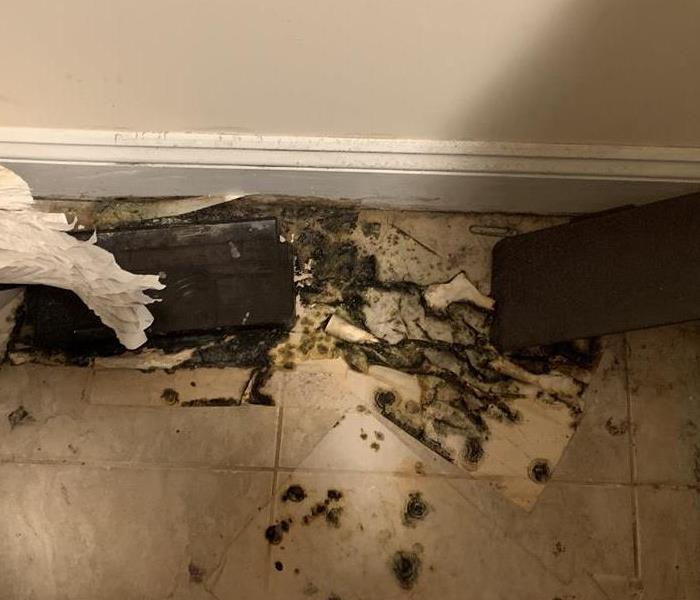 Burnt material behind a dryer that fortunately did not spread to create a structure fire.
Burnt material behind a dryer that fortunately did not spread to create a structure fire.
Dryer fires are a serious issue that causes thousands of fires in the US each year. Clogged vents can easily cause the lint buildup to ignite and quickly spread to the surrounding areas. The homeowner in the attached photo was extremely lucky that the buildup behind the dryer ignited but the fire did not spread to the surrounding material causing a structure fire.
Dirty or clogged dryer vents and ductwork reduce your dryer’s performance and efficiency. However, the buildup of heat, dryer lint, and dust can lead to a fire hazard. It is recommended that dryer ducts and vents be cleaned annually to keep your units running efficiently and safely.
If you have not cleaned your ducts/vents recently, and especially if you are experiencing any of the following warning signs, call SERVPRO today.
Warning signs:
- laundry taking longer to dry
- the clothes dryer becoming hotter to the touch
- a burning smell becoming noticeable in the laundry room.
Call SERVPRO today!
Gas Safety - Part 1
3/29/2021 (Permalink)
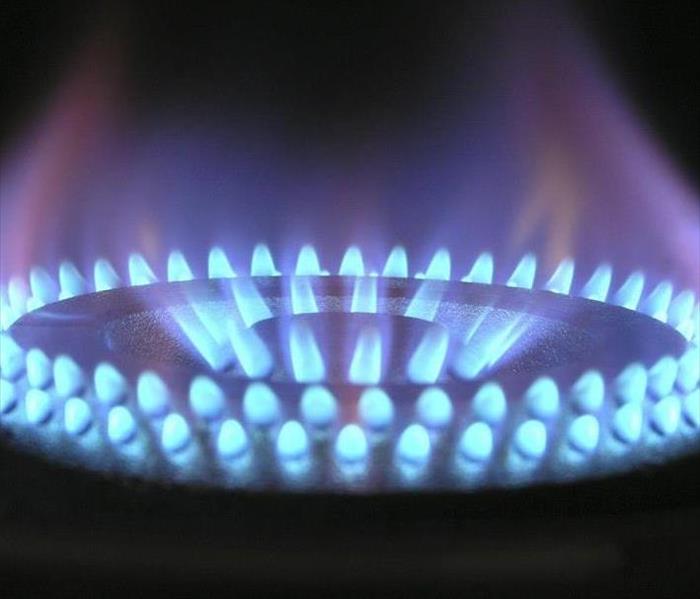 Blue flame from a gas burner
Blue flame from a gas burner
This month marks the anniversary of the 1994 Durham Woods gas pipeline explosion in Edison, NJ. This sudden explosion of a 36-inch gas pipeline was caused by minor damage from a backhoe years earlier that slowly deteriorated the pipe until it ruptured causing a ball of flame and mushroom cloud so large that one pilot flying into Newark Airport reported it as a nuclear blast.
Fortunately, these incidents are very rare. However, more mundane gas (propane or Natural gas) incidents are very common and are easily managed if you know what to do. First, call 911. This article is not intended to teach you what to do as an alternative to calling for professional assistance. The fire department and gas companies are very willing to come and help. Beyond their level of training, they have specialized tools that you won’t find in your toolbox.
Tips to prevent a gas fire/incident:
- Make sure all appliances that use Gas including furnaces, ovens, dryers, fireplaces, grills, etc. each have shut off valves that are easily accessible and functional.
- Download the SERVPRO Emergency Response Plan App and document the location of valves so you can easily share the info with friends/neighbors/first responders if you are not home.
- Have gas appliances serviced annually. Consider a service plan from PSE&G or NJNG which are a great value.
Gas Safety - Part 2
3/29/2021 (Permalink)
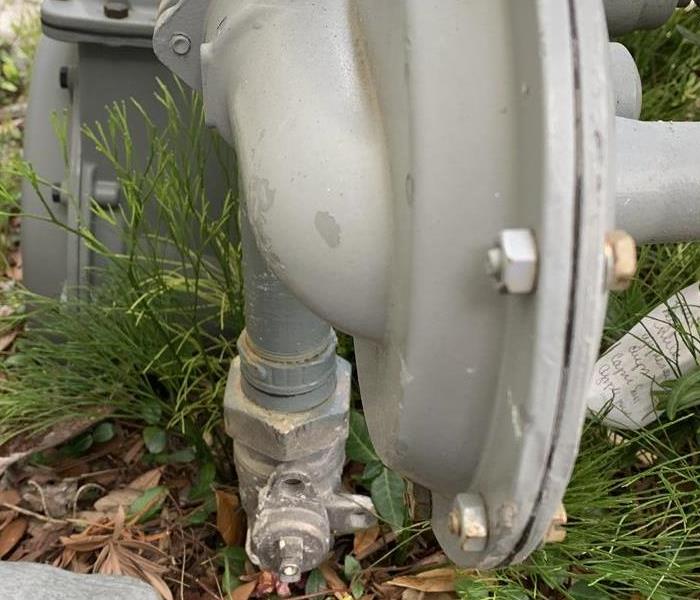 Gas meter showing shut off valve and regulator
Gas meter showing shut off valve and regulator
Natural Gas is non-toxic. It is also naturally odorless but a chemical called mercaptan is added to give it the distinct rotten eggs smell. If you smell gas in your home, call 911. You should leave the house and wait for first responders at this point. But, if you are like me and feel the leak is minor and want to address it here are some tips.
- Don’t turn on any lights or create any ignition sources.
- If the leak is coming from an appliance such as a stove or clothes dryer, see if there is a shut off valve to the unit and turn the valve handle so it is perpendicular to the pipe.
- If the leak is stopped and you want to ventilate the structure remember that natural gas is lighter than air and will float to upper floors while propane is heavier than air and will flow downstairs.
- If the leak is significant and not able to be stopped at a remote valve, the main gas line can be turned off where it enters the house. Typically a pipe comes out of the ground and runs through a regulator and meter before entering the house. There is usually a valve on the pipe before it reaches the regulator (the disk-like piece). This will turn off all of the gas to your home but will require a plumber to resume service.
- Use caution when digging. You can call 811 and have the utility companies mark their connections for free. Gas lines are plastic and can be punctured with a good shot from a spade shovel. These lines are only required to be a foot below ground and usually go straight from the gas connection to the street.
If the possible source is not obvious wait for the first responders. They have meters to test the overall gas levels in the building as well as “sniffers” that can pinpoint the exact location of the leak. They will attempt to isolate the leak and minimize the impact on your home/business until your plumber can make the repair.
Is Your Smoke Detector Working?
2/25/2021 (Permalink)
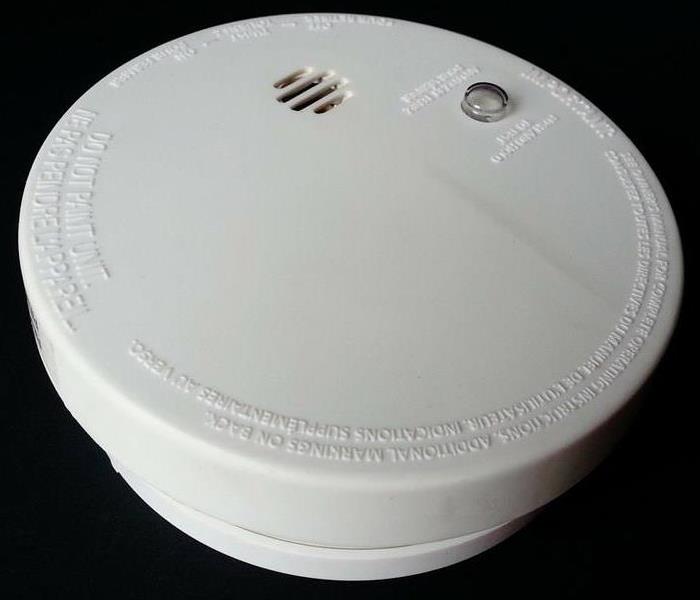 A typical smoke detector
A typical smoke detector
Are your smoke detectors working correctly? In many homes and businesses the answer is no. Often the problem is that they are perceived as a hassle and there are too many false alarms. The information below will help you troubleshoot your system because the simple fact is that smoke detectors save lives and prevent property damage.
All too often the answer for property owners is to disable the system to avoid the nuisance alarms. The batteries are removed, the system is disabled, or the devices are removed entirely. This is usually undetected, especially in private homes where fire officials do not perform regular inspections and have limited enforcement powers.
There are 3 basic types of systems but the tips below are largely the same for each. Single station units are the ones you buy at the hardware store and screw to the ceiling.
Hardwired/interconnected may look the same but they activate as a group ensuring that all areas of the home get the message. These first 2 types only notify the occupants. Monitored systems may be wired or wireless but they notify the fire department when activated.
The smoke detectors themselves are typically one of 2 types: Ionization or photoelectric. Ionization units use a small amount of radioactive material that detects invisible particles created by the fire using electrical currents. They are more expense so most people have photoelectric units. Photoelectric units use a beam of light which is deflected by smoke particles to activate.
The main problem is that other “stuff” can enter the chamber, block the light, and set off an alarm. This includes dust and bugs. The most common unwanted cause of activation is a contractor sanding near the unit. This is easily identifiable but a little spider passing through often makes the owner think the device malfunctioned.
To prevent issues follow these tips:
- Cover the detector when working nearby, especially sanding
- Put a monitored alarm system on test if you are doing something that may activate the system
- Change your batteries each time you change the clocks
- Use a vacuum to clean the unit periodically
- Units have a manufacture date on the back of them and they expire after 7-10 years depending on the brand. Replace them when needed.
Whatever you do, don’t disable these important systems. The fire department would much rather respond and find a minor issue than fight a significant fire because your system was disabled. Your local fire department is most likely offering a complementary home safety survey which can answer any questions you have along with other helpful advice.
Grab the Fire Extinguisher
1/28/2021 (Permalink)
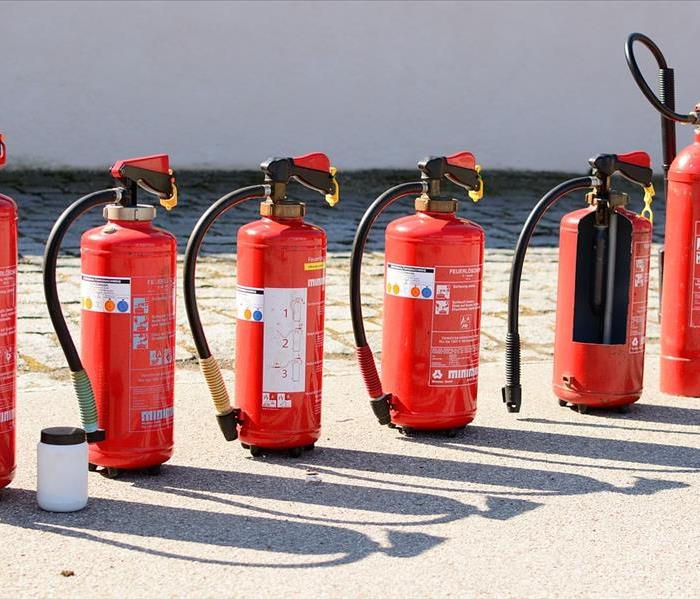 Several Types of Fire Extinguishers
Several Types of Fire Extinguishers
One of the most obvious things you can do to limit fire damage is to extinguish the fire quickly. However, some of the most common causes of residential fires are Cooking (48%), Heating appliances (14%), and Electrical malfunctions (14%), and these are not safely or effectively extinguished with water.
I am a firefighter and last night we had a call at 4AM caused by an electrical outlet which was sparking and catching the wall on fire. These calls are very routine. As a homeowner, you do not want to spray water on an electrical outlet due to the risk of electrical shock. YOU NEED TO HAVE A FIRE EXTINGUISHER IN YOUR HOME!
Fire extinguishers come in a variety of types based on the classification of fire they are designed to extinguish. For home use you should have a class ABC extinguisher which means is can extinguish class A fires (solid materials like wood), class B fires (liquids like gasoline or oil), and class C fires (electrical equipment).
Most towns require at least 1 extinguisher under the kitchen sink in order to obtain a certificate of occupancy to sell a home but these tend to disappear over time. Personally, I keep one under the sink, one on the wall in the laundry room, and one in the garage. At least maintain the class ABC extinguisher under your kitchen sink at a minimum.
If you do experience a fire, call the professionals at SERVPRO to help restore your home, “Like it never even happened.”
Proper Soot Remediation
1/20/2021 (Permalink)
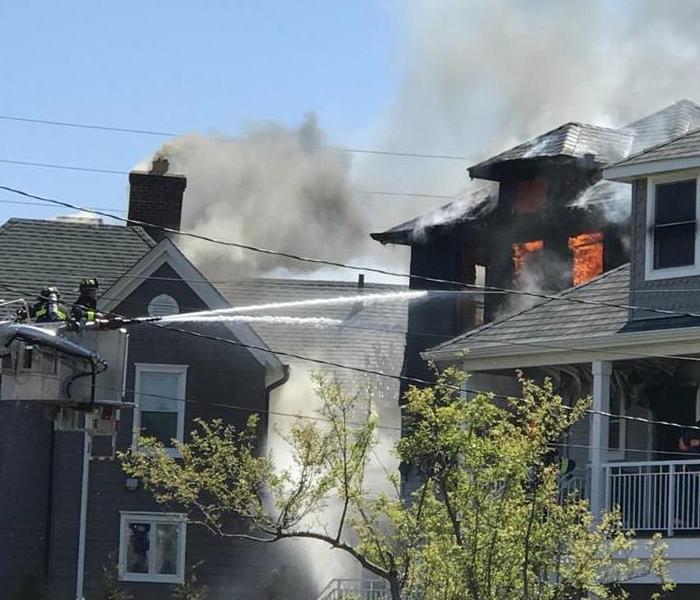 Smoke-filled Houses
Smoke-filled Houses
The possible health effects of a fire can last long after the flames are extinguished. In fact, decontamination of soot and environmental exposures is the “hottest” topic in the fire service today. The nasty chemicals caused by fire can linger for long periods of time on surfaces and in belongings. Make sure these items are professionally cleaned.
Soot is made of tiny particles created by incomplete combustion, technically called pyrolysis. (Fun fact: solids and liquids can’t burn. Heat at the surface of these materials is converting them to gasses which burn.) Even the basic wood used in framing (Douglas Fur) causes 75 different chemicals including poisons such as hydrogen cyanide and phosgene. These particles linger in the form of soot leaving a dangerous smelly mess.
During a fire, soot spreads to the whole house, attaching to surfaces. The acidic properties of soot can further damage your home and indoor air quality if the soot is not removed immediately.
Soot can inhabit your home even without a fire. Candles can lead to soot buildup, fireplaces can release soot as well if not ventilated properly, and furnaces are also a source of soot contamination when they produce a puff back (reference our blog on puff backs at What is a Puff Back? .)
To avoid the health risks of soot exposure after a home fire, make sure that all soot-affected areas are properly cleaned and sanitized.
When cleaning soot, wearing safety equipment to protect the lungs, skin, and eyes is essential in reducing soot exposure. Specialized techniques such as air scrubbing are also needed to restore indoor air quality following a fire.
A dust mask and a household cleaner are not enough to clean up soot! Removing soot requires professional tools, knowledge, and expertise. Certified experts at SERVPRO can properly clean soot and odors from your entire home to ensure it is safe to inhabit.
If you are concerned about these exposures in your home, call us today for a consultation at 732-578-9888.
Does SERVPRO Work with Homeowners Insurance Company After a Fire?
10/23/2020 (Permalink)
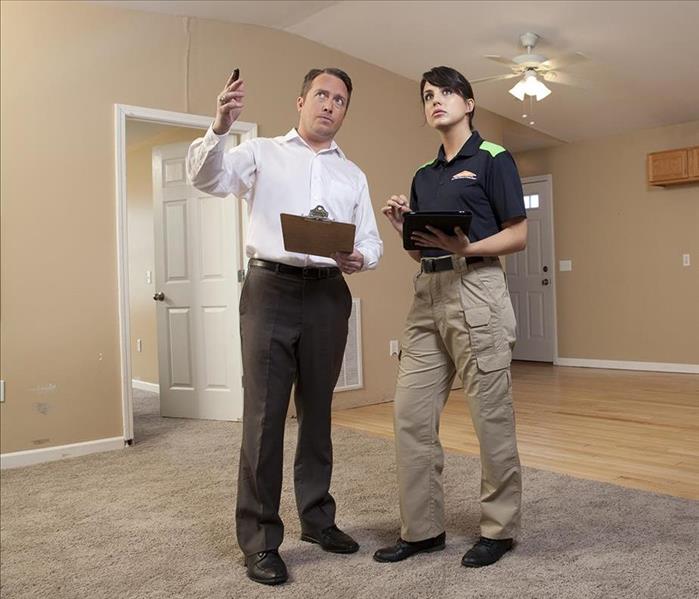 Rest assured, SERVPRO works closely with your insurance company. Call us anytime for assistance.
Rest assured, SERVPRO works closely with your insurance company. Call us anytime for assistance.
Little Silver Homeowners Can Trust SERVPRO to Work Closely with Insurance Companies.
The leading cause of fire-related deaths, injuries, and property loss is residential fires. Most of these homes, thankfully, are covered by homeowner’s insurance. When it comes to assisting Little Silver residents with fire claims, a professional restoration company is vital.
How Does SERVPRO Assist Both the Homeowner and the Insurance Company?
Whenever a fire has occurred, the insurance company works with the owners to decide the extent of the loss. This process involves the homeowner, insurance company, insurance adjuster, and the restoration company. In many cases, the insurance company requires a professional company to work with them to ensure that everything gets done professionally. At SERVPRO, our services go beyond fire cleanup in Little Silver. What we do is designed to assist all parties involved and includes:
- Minimal loss prevention - By providing immediate fire mitigation, more can be salvaged. Prompt action reduces secondary damage and property loss.
- Scoping information – The details we provide during the initial scope allow the insurance agent to review inspections and reports. He then can prioritize items on the work schedule.
- Assessing restoration needs – Our technicians help the insurance adjuster and owner decide what gets cleaned and what needs to be declared a loss.
- Working with adjusters – Our professional teams provide scoping, testing, and loss details that save the insurance adjuster time.
- Managing the restoration job –When our technicians handle the various aspects of restoration, the insurance company and homeowner do not need to waste time on minor, time-consuming tasks.
- Restore instead of replace – Our goal is always to restore instead of replacing whenever possible. This saves everyone time and money.
- Customer satisfaction – we know how a fire can impact your home. If possible, we restore your home to preloss condition.
SERVPRO provides an invaluable service by working closely with residents and their insurance companies. As our company works closely with the adjuster, the stress is taken off the homeowner. The agent’s job goes smoother due to the detailed information we provide early in the process. When our Green Team provides fire cleanup services, we are doing more than cleaning – we are helping you get your life back on track.
Contact SERVPRO of Eatontown / Long Branch at (732) 578-9888 for professional fire cleanup services. We’re Faster To Any Size Disaster.
What Are Airborne Concerns in Fire-Damaged Homes?
10/7/2020 (Permalink)
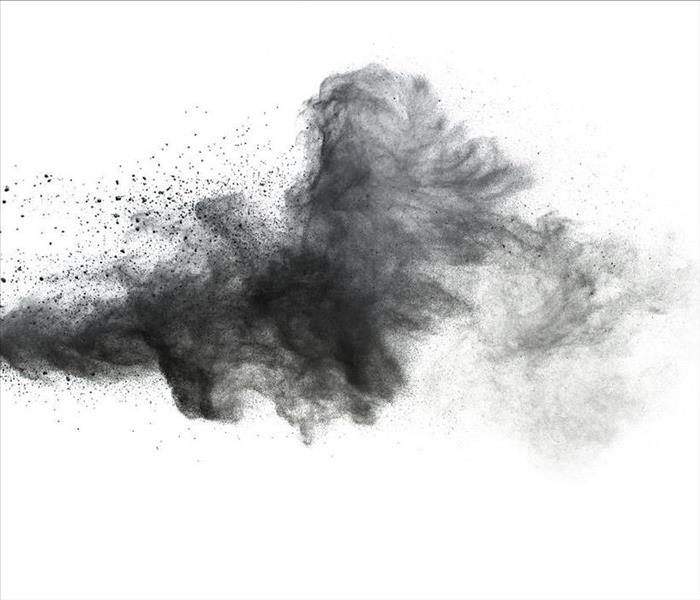 SERVPRO Cleans and Restores Fire Damaged Homes in Fair Haven. Removal of Airborne Soot and Ashes improves Indoor Air Quality while Reducing Odors
SERVPRO Cleans and Restores Fire Damaged Homes in Fair Haven. Removal of Airborne Soot and Ashes improves Indoor Air Quality while Reducing Odors
Mitigation should begin as soon as possible after a fire in Fair Haven homes, and the fast response of our SERVPRO team can help.
After a fire in your Fair Haven home, professional mitigation seeks to reduce loss and ultimate costs for the customer. Our SERVPRO team can work quickly to manage the situation with containment protocols and remove pressing safety and health concerns from the property to begin restoration actions.
Among the chief concerns of fire damage in Fair Haven properties are airborne contaminants and health threats. Addressing particles and particulates left behind from combustion and extinguishment can be vital in making the property safer for occupants and our responding technicians. Some of these circulating threats include:
- Soot – Soot is among the most hazardous of airborne and stationary byproducts of combustion. These potential carcinogens can directly impact those exposed, so our SERVPRO team utilizes filtration efforts to remove these particles from the environment.
- Smoke/Ash – Smoke and ash particles can create a residue on surfaces and stain materials hosting these layers.
- Odors – Burning odors and smoke scents can move quickly throughout the property, beginning at the ignition point and using channels like structural openings and the HVAC system to spread.
- Contaminants/Toxins – A lesser-considered obstacle for responding technicians is the combustion of toxic materials and products that can also become a threatening condition for the house.
Can the HVAC System Become Damaged by Spreading Soot?
Because of the magnetism of soot particles, sheet metal used in your home's ductwork can attract ionized soot into the system. While this can distribute soot and smoke to new areas of the property, much of it can also remain attached to the inner walls of the HVAC network itself.
We have a fast and reliable response to manage fire loss effects in your home. Whenever these disasters occur, count on our SERVPRO of Eatontown / Long Branch team. Give us a call today at (732) 391-6141.
Smoke & Soot Cleanup
6/3/2020 (Permalink)
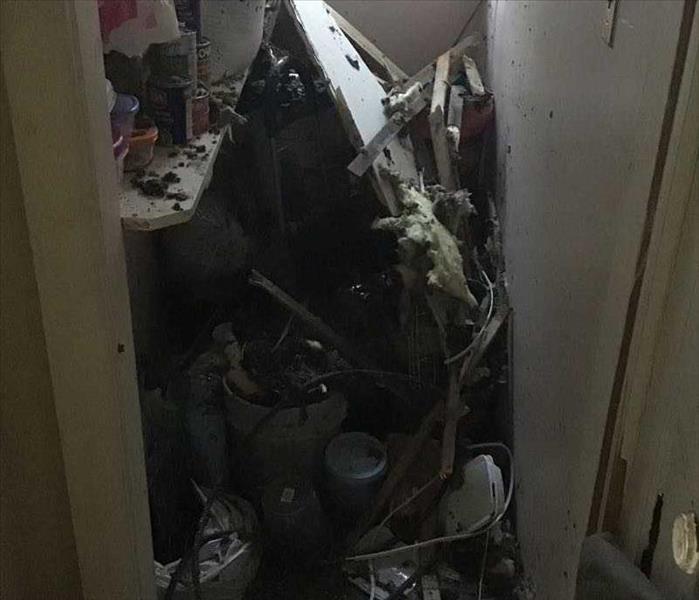 This is the damage caused by a fire.
This is the damage caused by a fire.
Smoke and soot is very invasive and can penetrate various cavities within your home, causing hidden damage and odor. Our smoke damage expertise and experience allows us to inspect and accurately assess the extent of the damage to develop a comprehensive plan of action.
Smoke and soot facts:
- Hot smoke migrates to cooler areas and upper levels of a structure.
- Smoke flows around plumbing systems, seeping through the holes used by pipes to go from floor to floor.
- The type of smoke may greatly affect the restoration process.
Different Types of Smoke
There are two different types of smoke–wet and dry. As a result, there are different types of soot residue after a fire. Before restoration begins, SERVPRO of Eatontown/Long Branch will test the soot to determine which type of smoke damage occurred. The cleaning procedures will then be based on the information identified during pretesting. Here is some additional information:
Wet Smoke – Plastic and Rubber
- Low heat, smoldering, pungent odor, sticky, smeary. Smoke webs are more difficult to clean.
Dry Smoke – Paper and Wood
- Fast burning, high temperatures, heat rises therefore smoke rises.
Protein Fire Residue – Produced by evaporation of material rather than from a fire
- Virtually invisible, discolors paints and varnishes, extreme pungent odor.
Our Fire Damage Restoration Services
Since each smoke and fire damage situation is a little different, each one requires a unique solution tailored for the specific conditions. We have the equipment, expertise, and experience to restore your fire and smoke damage. We will also treat your family with empathy and respect and your property with care.
Have Questions about Fire, Smoke, or Soot Damage?
Call Us Today – 732-578-9888
What To Do With Contents After a Fire
3/24/2020 (Permalink)
Fires are devastating. If contents aren't destroyed by flames, they can be rendered useless by smoke and soot.
Four items you should definitely throw away:
- Food Exposed to Fire and Heat - any foods that come contact with the flames, smoke, high heat, including foods stored in the refrigerator or freezer.
- Fabrics
- Mattresses
- Medicine and Cosmetics
- Electric Appliances
Three examples of items that can often be salvaged after a fire.
Hardwood - unless there is extreme burning or charring, use an oil soap made especially for wood to clean off stains.
Glass - if it doesn’t melt, try cleaning it with white vinegar or dish soap. You can also try to soak it in vinegar and baking soda.
Metal - use vinegar or dish soap and then try to gently sand and paint the metal.
Note: never try to keep items that may be melted, charred, or rendered structurally unsafe.
If you need help trying to salvage and/or restore your property and belongings after a fire, our team of experts here at SERVPRO of Eatontown/Long Branch is close by and ready to help! Whatever the size of your fire damage, we have the know-how, training, and tools to help you deal with it and move forward.
5 of the Most Important Winter Fire Safety Tips You Need to Know
2/26/2020 (Permalink)
These are the days of the year when we expect temperatures to remain chilly if not freezing, and it’s common for use multiple heating sources to keep your house warm. Unfortunately, that means it’s also a time when there’s a greater risk of fire damage.
Too many homes suffer from fire damage that could have been prevented with just a little foresight and planning. In order to help you keep your family safe from fire during the cold weather days, here are 5 of the most important Winter Fire Safety Tips you should act on:
Check Your Smoke Alarms
Ideally, you would have checked your smoke alarm batteries when the clocks changed. But now is the season when it might actually make a difference, so make sure that your batteries are good for the winter.
Also, there should be smoke alarms in every bedroom plus the kitchen and laundry room at bare minimum. Make sure you have enough smoke alarms strategically placed all around your home.
Inspect Your Chimney
If you use a fireplace, you should know that they can produce creosote, which is a flammable substance.
If your family likes to light fires in the fireplace, you should get an annual chimney inspection to ensure there are no fire hazards.
And don’t forget to use dry, seasoned wood, which will give you bright flames with less smoke. Excess smoke could lead to smoke damage.
Always Use a Screen for Your Fireplace
Whether you prefer a metal screen or a screen of tempered glass, you want to make sure to protect against any sparks that might otherwise stray from the fireplace.
Even with a screen in place, be sure to keep curious children and pets safely away from the fireplace. Also, any potentially flammable fabrics or materials should be kept at least three feet away from a lit fire.
Maintain Your Furnace
Typically, it’s a good idea to invest in an annual inspection from a professional. They can check your system for the signs of wear and tear or potential damage that could lead to furnace problems.
Use Candles and Space Heaters with Caution
Candle create a lovely atmosphere and may even provide extra light on the darkest of days. Make sure, however, they are placed securely where they won’t get knocked over, as well as safe out of the reach of young children and pets.
And don’t forget to blow them out when you leave the room!
Similarly, with space heaters, you want to make sure to keep sufficient clear space around them (typically at least 3 feet all the way around) to prevent a potential fire hazard. Make sure the heater you use has an automatic shut-off switch so that its internal mechanisms won’t overheat.
And make sure to turn it off before you go to sleep or move to a different room!
Here at SERVPRO of Eatontown / Long Branch, we have a strong track record of protecting the people and properties of this community from the horrifying effects of fire damage. We’re known not only for our reliability and expertise as a professional restoration and cleaning services provider, but people love us for our friendly customer service too.
For help with Fire Damage cleanup and restoration, you can give us a call any time 24/7.
What To Do After a Structure Fire
1/27/2020 (Permalink)
A fire in your home or business is always traumatic, and knowing what to do next usually adds to the stress and anxiety already experienced. Most people are unsure of what the next steps should be.
It's always best to call experts who know the behavior of smoke and soot to clean up and restore the building, but there are a few things that can be done to increase the chances of a successful restoration.
- Limit the amount of foot traffic within the property. Soot particles can be spread to unaffected areas and embed themselves into carpet and furniture fibers.
- Keep your hands clean. Transferring soot and other fire-related substances can further soil the walls, upholstery, woodwork, etc.
- Electricity is often turned off, empty refrigerators/freezers. Leave doors open to reduce odors.
- Cover air registers with cheesecloth, and double layer the tape. If cheesecloth is unavailable, use any similar fabric that will keep soot particles out of the HVAC system.
- If your electricity is off, your heating system will not operate. In the winter, pour antifreeze designed for RV's and Campers in your sinks, toilet bowls, holding tanks and bathtubs to "winterize" your home and keep pipes from freezing.
As smoke and soot can leave a film on surfaces (different kinds of smoke will have different properties, and will require different cleaning methods), leave ALL cleaning to SERVPRO of Eatontown/Long Branch.
Do not:
- Attempt to wash any walls or painted surfaces.
- Shampoo carpet or upholstery
- Clean any electrical items. Cleaning these should be left to professionals. Most likely they should be discarded.
- Use or consume any canned or packaged food or beverage that may have been near the fire, heat or water. Varying conditions can alter the integrity of food items.
- Use or turn on any electrical device, including ceiling fixtures or outlets, wiring can be damaged by water.
- Send garments to an ordinary dry cleaner. Improper cleaning may cause smoke odor to set in.
If you ever have a fire, SERVPRO of Eatontown/Long Branch has certified technicians who know the properties of smoke and soot, and will be able to professionally and thoroughly clean and restore your property. Call us any time, we are open 24/7.
Fire Damage? How to Start the Cleaning Process
10/21/2019 (Permalink)
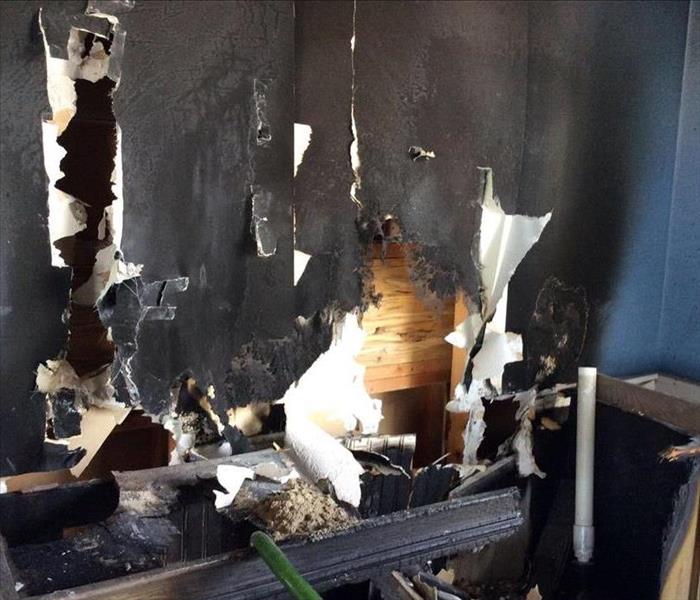 Calling SERVPRO of Eatontown/Long Branch helped this homeowner clean up after a fire.
Calling SERVPRO of Eatontown/Long Branch helped this homeowner clean up after a fire.
If you’ve experienced fire damage in your home or business, you’ve undoubtedly observed that smoke and soot can unfortunately damage almost all kinds of surfaces and materials. While some items are easy to replace, it’s a good idea to try to salvage as much as you can.
The good news is: there are many fire damaged items you can clean (or at least start to clean) all by yourself with easily available cleansers and cleaning techniques. In fact, it’s a good idea to get started cleaning as quickly as you can, in order to prevent the effects of long-term damage. However in most cases, CONTACT YOUR INSURANCE COMPANY, everything from cleaning to replacement is most likely covered.
Here’s a guide to help you get started cleaning up after a fire:
Remove Smoke and Soot Stains from Wood
As long as your wooden items aren’t charred, you should be able to clean them with a mild oil soap. Rinse with water, and let them air dry.
Remove Smoke and Soot Stains from Upholstery
If you can remove stained upholstery, bring it to a dry cleaner that specializes in cleaning fire damaged fabrics. At home, you could try washing it in a solution of water mixed with white vinegar and baking soda.
If you have upholstery that’s can’t be removed, start by vacuuming the surface with a shop vac, keeping the hose just above the surface to prevent rubbing in the stain even more. Next, sprinkle the stain with baking soda and allow it to sit for at least one hour. Then, spray the stain with white vinegar and wipe with a damp rag.
For hard-to-clean stains, you may have to let the baking soda sit longer (sometimes overnight) and/or repeat the cleaning process multiple times.
Remove Smoke and Soot Stains from Metal
When cleaning metal, you want to be sure to use a polish that is specially designed for the specific type of metal you have. Typically, the process is just to gently rub the stain with the polish and then wipe away with a clean rag, but be sure to follow the manufacturer’s instructions.
Remove Smoke and Soot Stains from Glass
To clean glass, you can often use a commercial glass cleaner or a homemade solution of one-part water to one-part vinegar. You’ll want to avoid spraying the glass, as this can leave smoke streaks. Instead, apply the solution to the rag and start wiping at the edge of the stain moving inward.
Remove Smoke and Soot Stains from Leather
You can clean fire damaged leather with a specialized leather soap and conditioner.
You want to be sure not to get the leather too wet, as this can create additional stains. Also, you’ll want to apply the soap gently to avoid scratching the leather.
If you need help to restore your property after fire damage, SERVPRO of Eatontown/Long Branch is always available to help.
SERVPRO Is Here to Help You Clean Up After Smoke Damage
9/30/2019 (Permalink)
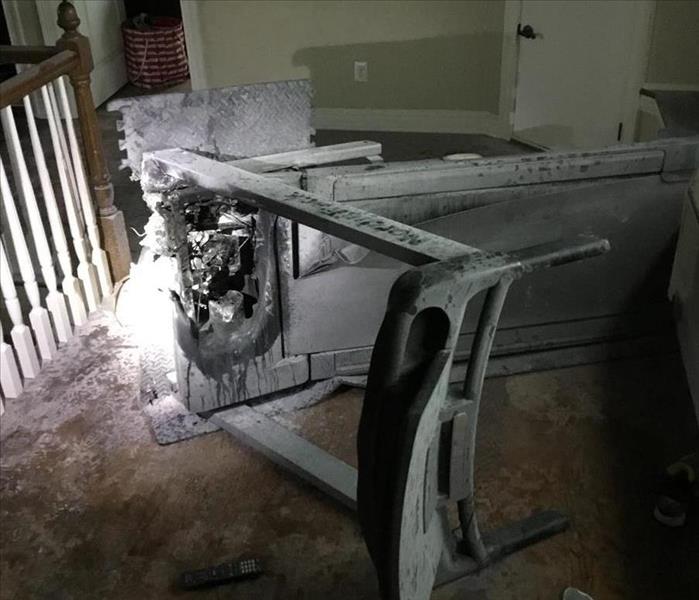 Soot and fire extinguisher dust will cover every surface and is usually difficult to clean.
Soot and fire extinguisher dust will cover every surface and is usually difficult to clean.
Smoke damage can make your home a dirty, smell mess. Whether you’ve suffered a major fire catastrophe or had smoke damage accumulate from the presence of fire in your home, you want to start cleaning up smoke stains as soon as you can in order to prevent permanent damage.
Our team at SERVPRO of Eatontown/Long Branch has seen our share of fire incidents as Professional Cleaning and Restoration Leaders in this community so, we know what smoke damage can do to a home.
Make Sure the Area is Safe
If your incident was a small kitchen grease fire, there is probably minimal risk. However, if fire burned through a significant section of your home, you want to be sure the area you enter is structurally sounds and cleared by officials before anyone can attempt to start fixing it.
Dispose of Everything that Can’t Be Salvaged
The first step of the cleaning process is to get rid of everything that can’t be saved.
Be especially wary of food that may have been contaminated, plastics that may have melted, or materials that are too stained to be cleaned.
Vacuum Up Debris
We have specialized equipment to clean up debris.
Soot is greasy, it is best to wait for a professional to clean soot-stained surfaces and making a bigger mess.
Clean up Odors
You can clean some fabric and upholstery yourself that may have avoided smoke stains may still have absorbed odors.
If you have fabrics that are dry clean only, be sure to take them to a dry cleaner that specializes in smoke removal or fire treatment.
For fabrics that can go in a washing machine, add a cup of white vinegar and a cup of baking soda to your regular load to clean the smoke damage. A mixture of white vinegar and baking soda can also be used to spot clean carpeting and upholstery.
Seal Surfaces
Even after a full cleaning, there may still be some lingering stains and odors. To mitigate this, we use a sealing primer.
We use specialized sealers for different surfaces. For example, on painted walls, we use a stain concealing primer followed by a topcoat of latex paint. For wooden surfaces, we use a sealer designed specifically for wood or particleboard.
If you need professional assistance in cleaning up after a fire incident, SERVPRO of Eatontown/Long Branch is here to help. Our specialized technicians have the advanced training and equipment needed to clean and restore your property, helping you get your life and property back to normal ASAP.
SERVPRO Wants to Help You Prevent Summertime Fires
6/17/2019 (Permalink)
Summertime is the season for backyard barbecues, fireworks, and time spent enjoying the outdoors, maybe even sitting around a fire pit. This means there’s also an increased potential for a fire emergency.
Here’s a guide that can help keep your home and/or local business safe from fires this summer:
Practice Grill Safety
It’s a good practice to make sure your grill is at least 3 feet away from the house and any other structures or objects that could potentially catch on fire. Be wary of any overhanging tree branches!
Regularly clean the grill and remove any grease build up. Also, always make sure you have water and a fire extinguisher nearby when you’re grilling, just in case
Monitor Your Air Conditioning
Air conditioning, fans, and other cooling equipment are a frequent cause of summertime fires. Typically, they occur from electrical or mechanical failures.
One way to make sure your equipment is in good working condition is to schedule regular maintenance. You can also make sure to change the filter and remove any dirt or debris.
In order to prevent overuse, try turning your air conditioner off during peak hours. You can also adjust your thermostat when you leave for more than one hour to maximize efficiency.
Check Your Lawnmower
Don’t let a faulty lawn mower be the cause of a fire!
Be sure to check the engine, mufflers, and cutting blades and keep your machine clean and well maintained. If your lawn mower overheats, wait for it to cool down before trying to refuel it.
Be Cautious with Fireworks
If you live somewhere where fireworks are legal, they can add some extra pizzazz to your summer parties. Just be sure to use them with caution!
Make sure to follow all the local laws, and heed any warnings or instructions that come with your fireworks. Make sure to keep your fireworks at a safe distance away from people, buildings, and any flammable objects.
And always keep a bucket of water on hand, just in case!
These summertime fire prevention tips can go a long way to keeping you safe. However, if you still do experience a fire accident, know that SERVPRO of Eatontown / Long Branch can help you take the right steps to get your home or business back in shape. We often even can help you work with your insurance company.
SERVPRO Can Help After a Fire
3/21/2019 (Permalink)
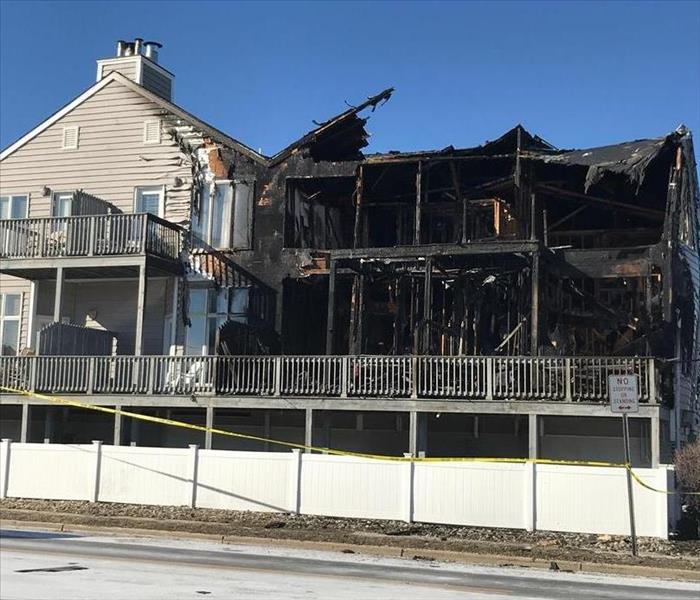 While we unfortunately can't do anything for the structure that is gone, SERVPRO CAN remediate and clean the surrounding structures.
While we unfortunately can't do anything for the structure that is gone, SERVPRO CAN remediate and clean the surrounding structures.
Having a fire in your home is a devastating and traumatic experience. No matter how small, soot, smoke and ash can creep into every crevice of your home, leaving a fine film over surfaces, ash everywhere and a lingering odor.
Having a fire in a structure next to your home can be just as devastating, as fire may destroy siding, smoke and ash may enter your home and water used to put out the fire next door can also affect rooms in your home as well. It can be just as traumatic not knowing what to do or whom to turn to.
SERVPRO of Eatontown/Long Branch is here to help. We have certified, experienced and professional technicians who will come to clean and deodorize – finding every place soot and odor can hide. We are also experts in content cleaning like furniture and have services that can clean documents, photos, artwork, rugs and window treatments. We can also tarp your home where damage has occurred or board up windows and doors if needed.
Whether you experience a fire in your home or are affected by one next to you, remember that SERVPRO is here to help, and truly can make it “Like it never even happened.”
Smoke is Sneaky - It Gets Everywhere
3/21/2019 (Permalink)
Smoke damage from a fire, no matter how large or small, can be devastating. Oftentimes smoke damage can be long lasting because the odor soaks into every surface including walls, furniture, window treatments, flooring, and wall studs.
Behavior of Smoke
A fire loss can be very complex because of the unique behavior of smoke. SERVPRO® Franchise Professionals undergo extensive fire restoration training and certification, and understand the behavior of smoke.
- Hot smoke migrates to cooler areas.
- Smoke migrates to upper levels of a structure.
- Smoke flows around plumbing systems, using holes around pipes to go from floor to floor.
Knowing how smoke penetrates and lingers is only one part of being able to mitigate smoke damage. Knowing what types of smoke will greatly affect the restoration process as well.
Knowing what type of smoke has affected your home is also important.
- Wet smoke- Plastics and Synthetics
- Dry smoke- Paper and Wood
- Protein Fire Residue- Produced by evaporation of material rather than from a fire.
- Fuel Oil Soot- Furnace Puff Backs
Because we are experts in dealing with fires, we know how to clean it professionally and completely. It is important to understand why you need to call us in the event of a fire, no matter how large or small. The professionals at SERVPRO of Eatontown/Long Branch will help get you back to your lives and jobs as soon as possible, making it “Like it never even happened.”
4 Tips to Prevent Fire Damage During the Cold Weather Season
1/29/2019 (Permalink)
Did you know there are more fires during the Winter months than any other time of the year? During the cold weather season, it makes sense that people are looking for extra ways to keep warm. Unfortunately, many alternative heating methods can also be fire hazards, especially when they’re not approached with care.
If you want to protect your home and/or business from fire damage during this cold weather season, here are 4 tips to keep in mind:
Know the Dangers of Fireplaces and Wood Burning Stoves
Sitting in front of a fire on a cold winter’s night may sound cozy – unfortunately, a large percentage of fires start with issues to a chimney or fireplace.
- Shield the fireplace with a grate to prevent flying sparks from igniting in the room.
- Keep any flammable materials at least 4 feet away from the fire place.
- Perform regular maintenance and cleaning on your fireplace and/or wood burning stove.
- Make sure there are no cracks in your chimney and that the top is properly capped to keep out debris throughout the year.
Know the Dangers of Space Heaters
Space heaters are wonderful for keeping us extra warm on cold days. But this extra heating equipment is also a major cause of winter house fires.
- Use only space heaters with a “tip switch,” ones that shut off automatically if tipped over.
- Make sure to follow the manufacturer’s safety instructions.
- Keep the space heater at least 3 feet away from anything flammable.
- Make sure there is adequate ventilation and base/floor support in the areas where you will use a space heater.
Know the Dangers of Electric Blankets
On a cold night, it’s comforting to curl up in a warm bed. However, if you want to use an electric blanket, make sure to be cautious – these can quickly catch fire if the blanket material is ignited by an overheated electrical element within the blanket.
- Check for charred or frayed cords or any dark spots, these may indicate a potential problem with the electrical element.
- Don’t allow anyone or anything on top of the blanket when it is in use, this could lead to overheating.
- Similarly, don’t fold or tuck in the blanket when it is in use, as this could also lead to overheating.
- An electric blanket should never be left unattended or used while one is sleeping.
Make Sure Your Smoke Alarms are Working
If a fire accident should happen, you want to make sure your smoke alarms are in working order, so that you can address the issue immediately.
It’s generally a good idea to regularly check the alarms each year (many people remember to check the alarms on the days when daylight savings time changes). However, it’s also wise to double-check the alarms before you start a fire or use a heating element, just in case.
These tips can help make sure you, your property, and your family all stay safe during the cold weather season when we’re all trying to stay warm. If, however, you do experience a fire accident, know that SERVPRO of Eatontown / Long Branch is here to help. We pride ourselves on being “faster to any disaster,” no matter the size. And we can help you get back to normal ASAP!
Halloween Fires Can be Scary so Be Prepared
10/19/2018 (Permalink)
Halloween is almost here. It is a time of fun and festivities for children and adults alike, including decorating the house, dressing up in costumes, going out trick-or-treating, and attending spook-filled parties. But don’t forget about Halloween fire prevention!
Unfortunately, many of the favorite activities associated with Halloween can also be serious fire hazards, especially if precautions aren’t taken. According to the National Fire Protection Association, Halloween fires are responsible for $13 million in property damage every year, in addition to risks of injury and death.
In order to make sure you and your family stay safe, make sure to follow these Halloween fire prevention tips:
Consider Costume Length and Materials.
Dressing up can be one of the most fun activities associated with Halloween. Unfortunately, some costume can be fire hazards.
Look for costumes that are made of flame-retardant materials.
Avoid long-trailing costumes or outfits that are oversized and bulky.
Pay Attention to Decoration Locations.
Jack-o-lanterns and other candlelit decorations are always popular on Halloween. However, if you use real candles for these decorations, it is important to keep them in a safe location. Make sure they remain at least three feet away from people and things that could accidentally ignite.
Similarly, corn stalks, hay bales, and paper decorations need to remain at least three feet away from any heat source or flame. Flammable decorations that are too close to a light bulb or heater may start a fire.
Make sure no Halloween decorations are blocking your exits. If you need to escape quickly, you will want all paths out the house to be clear and easily accessible.
Choose an Alternative Light Source.
One of the best ways to keep safe on Halloween is to use battery operated lights or glow sticks instead of open flames.
If you and your family are going out trick-or-treating, be sure to carry a flashlight. Make sure it is bright enough so that you can see any potential fire hazards and so that others can see you and the full extent of your costumes.
Practice “Stop, Drop, and Roll”.
Advise young children to keep far enough away from any decorations that may have candles. And make sure they know to “stop, drop, and roll” if their costumes should catch on fire.
Check Your Fire Alarms.
October is Fire Prevention Month, so make sure to double check that your fire alarms are working properly, just in case.
Fire Damage? Why You Should Call Restoration Experts ASAP
10/1/2018 (Permalink)
If you’ve just suffered fire damage to your home, the aftermath can feel overwhelming. You may feel tempted to hole yourself up some place far away and safe, putting off the stress of dealing with the whole restoration process.
While this reaction is understandable, you should know that if fire restoration gets postponed, the extent of the destruction and damage to your home can grow even worse than it already is. The longer you wait, the more repairs you will probably need – and the more money it will undoubtedly cost you in the long run.
However, if you make restoration a priority, you can probably avoid many long-term issues and expensive repairs.
Here are some steps you can take to get your home -- and your life -- back to normal as quickly as possible:
Contact Fire Damage Restoration Experts ASAP
In order to reduce the risk of increasing damage to your home, it is essential to bring in help from licensed fire damage restoration professionals. Everyone’s situation is different, but here are some of the steps they are likely to help you with, making your safety and the protection of your valuables their number one priority:
- Salvaging as many of your personal belongings as possible, making sure they will be safe for future use (this includes furniture, appliances, other electronics, etc.)
- Documenting everything temporarily removed from the premises, either through written records or photographs.
- Performing any needed restoration services from the fire (here in NJ near to the shore, fire damage is also often accompanied by water damage – which the professional can also help you address).
- Returning and re-installing the belongings that were saved.
- Working as quickly and carefully as possible to get you and your family back living in your home, keeping in contact to make sure you aren’t experiencing any continuing issues.
Be on the Lookout for Prolonged Smoke Damage
Fire damage can be tricky to assess, because while some signs of damage are obvious (wall discolorations and smoke stains on surfaces), there are some instances of prolonged smoke damage that stay hidden and can go unnoticed, until they start causing problems.
For example, it is common for ash and soot to become trapped in vents or in the spaces between your walls. You fire damage restoration experts should make sure to check your HVAC system, attic, basement, and exterior walls to ensure that all contaminants are removed and cleaned. They should also keep in touch after the cleaning is done, to ensure there are no lingering issues.
Preventing Grill Fires
6/19/2018 (Permalink)
Summer is the time for lazy days, warm nights, fireflies and barbecues. Many families use their grill daily during the summer so they don’t heat the house and because clean-up is easy.
However, it’s always important to remember to use the grill safely to avoid injury or fire. Before lighting up, remember the following safety points.
According to the National Fire Protection Association:
- Propane and charcoal BBQ grills should only be used outdoors.
- The grill should be placed well away from the home, deck railings and out from under eaves and overhanging branches.
- Keep children and pets away from the grill area.
- Keep your grill clean by removing grease or fat buildup from the grills and in trays below the grill.
- Never leave your grill unattended..
Make safety checks with your propane tank & lines before you use your grill. Learn how to check your propane tank with this video from NFPA.org.
Charcoal grills
There are several ways to get the charcoal ready to use.
- Charcoal chimney starters allow you to start the charcoal using newspaper as a fuel.
- If you use a starter fluid, use only charcoal starter fluid. Never add charcoal fluid or any other flammable liquids to the fire.
- Keep charcoal fluid out of the reach of children and away from heat sources.
- There are also electric charcoal starters, which do not use fire. Be sure to use an extension cord for outdoor use.
- When you are finished grilling, let the coals completely cool before disposing in a metal container.
Remember that a fun summer also means a safe summer, and if you need SERVPRO of Eatontown/Long Branch for any fire or smoke damage, we are a phone call away 24/7.
Smoke 101
3/27/2018 (Permalink)
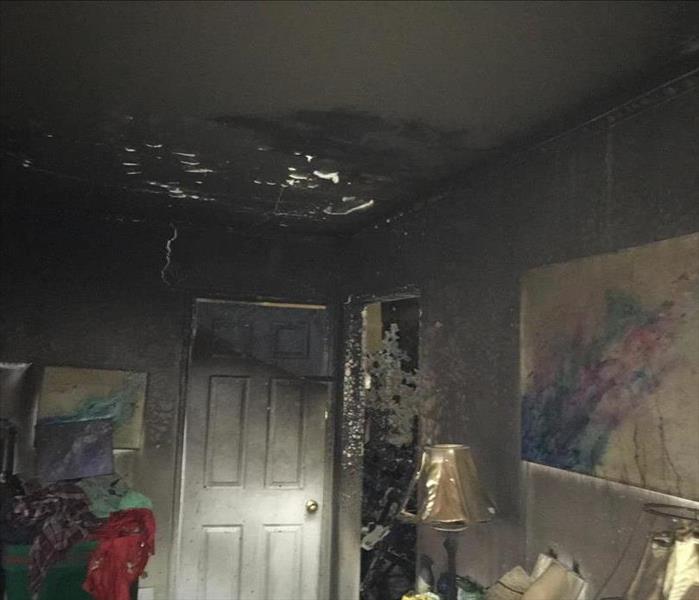 Fire leave smoke and soot damage throughout the home.
Fire leave smoke and soot damage throughout the home.
Smoke damage from a fire, no matter how large or small, can be devastating. Oftentimes smoke damage can be long lasting, which is why it is so important to take care of it immediately.
Behavior of Smoke
A fire loss can be very complex because of the unique behavior of smoke. SERVPRO® Franchise Professionals undergo extensive fire restoration training and certification, and understand the behavior of smoke.
- Hot smoke migrates to cooler areas.
- Smoke migrates to upper levels of a structure.
- Smoke flows around plumbing systems, using holes around pipes to go from floor to floor.
This enables us to take care of smoke throughout the entire home or office.
- Knowing how smoke penetrates and lingers is only one part of being able to mitigate smoke damage. Knowing what types of smoke will greatly affect the restoration process as well. Upon arriving at a fire scene, SERVPRO of Eatontown/Long Branch will test the smoke to see what type of fire has taken place.
Types of Smoke
- Wet smoke- Plastics and Synthetics
- Low heat, smoldering, pungent odor, sticky, smeary. Smoke webs are more difficult to clean.
- Dry smoke- Paper and Wood
- Fast burning, high temperatures, dry. Powdery, non-smeary residues. Heat rises therefore the smoke rises.
- Protein Fire Residue- Produced by evaporation of material rather than from a fire.
- Virtually invisible, discolors paints and varnishes, extreme pungent odor.
- Fuel Oil Soot- Furnace Puff Backs
- While “puff backs” can create havoc for property owners, SERVPRO® Franchise Professionals can, in most cases, restore the contents and structure quickly.
Other smoke related services we offer are:
Content Cleaning
- Smoke and soot residues and deposits can cause permanent damage to contents and may result in periodically resurfacing odors if not properly deodorized.
- All restorable contents in affected areas will be professionally cleaned and deodorized to preloss condition when possible. This includes area rugs, furniture, draperies, upholstery, electronics, clothing, photos, kitchen items, bedding and much more.
Deodorization
- SERVPRO® Franchises provide specialized services
that rid structures of offensive odors left by fire or smoke damage. We do not merely cover up lingering odors with a fragrance, we seek out the sources of the odor and remove them. - Proper deodorization is vital as odors may appear to be gone, only to reappear months later under different conditions, including when humidity levels rise.
It is important to understand why calling us in the event of a fire, no matter how large or small. The professionals at SERVPRO Eatontown/Long Branch will help get you back to your lives and jobs as soon as possible, making it “Like it never even happened.”
Fire Dangers After a Flood
3/6/2018 (Permalink)
 Electrical appliances such as this treadmill are in danger of catching fire after being submerged in flood water.
Electrical appliances such as this treadmill are in danger of catching fire after being submerged in flood water.
Fire is probably not the first thing you think of as the result of flooding, however it is a real concern and something every homeowner should be aware of.
It is well known that water and electricity DO NOT mix. It is important to remember that any electrical device that has been submerged in water could potentially be dangerous, as the wires may become compromised or corroded.
According to the Colorado Inspection Services, the rule of thumb for electrical devices that have been submerged is REPLACE them. The fire hazard from soaked electrical devices is not worth trying to save them.
As stated in their web site, outlets, switches and breaker boxes are the obvious electric devices that need replacement. Appliances, heaters, furnaces, AC units and anything else that contains electric motors, switches or wiring are included.
Flood waters may also contain mud and many toxic substances such as fuels, solvents, cleaning chemicals, industrial chemicals, sewage, fertilizers, pesticides, herbicides and other toxic compounds, that can deposit in these devices causing overheating and/or mechanical failure.
Winter is the Biggest Season for Home Fires
2/7/2018 (Permalink)
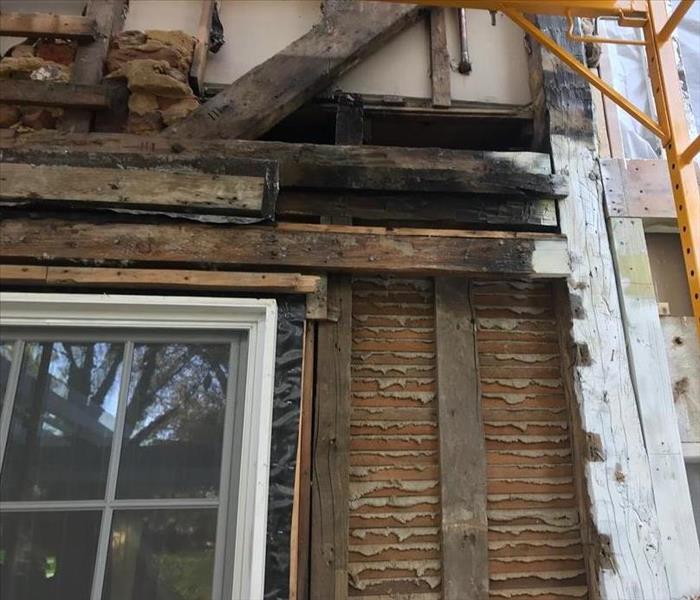 Home fires occur in winter more than any other season.
Home fires occur in winter more than any other season.
Did you know that, the threat of a home catching on fire is the greatest during the winter months? Half of ALL heating home fires occur during the months of December, January and February. One in Seven home fires is a result of malfunctioning or misused heating equipment.
There are several tips to keep your home safe while keeping warm during the winter.
- Have your fireplace, heating vents and dryer vents inspected and cleaned by a professional every year.
- If you use your fireplace, make sure you clean after every use. Dispose of ashes correctly by placing them in a metal can at least ten feet from the house.
- Keep anything that can burn at least three feet from any heat source like fireplaces, wood stoves, radiators, or space heaters
- Plug only one heat-producing appliance (such as a space heater) into an electrical outlet at a time.
- If portable generators are needed, keep them outside, away from windows and as far away as possible from your home. Make sure someone is home to supervise.
- Install and test carbon monoxide alarms at least once a month.
These are simple but effective steps to take to safeguard your home against fire. But should you ever need us, SERVPRO of Eatontown/Long Branch can clean fire, smoke and soot damage and make it “Like it never even happened.”
Christmas Tree Safety
11/29/2017 (Permalink)
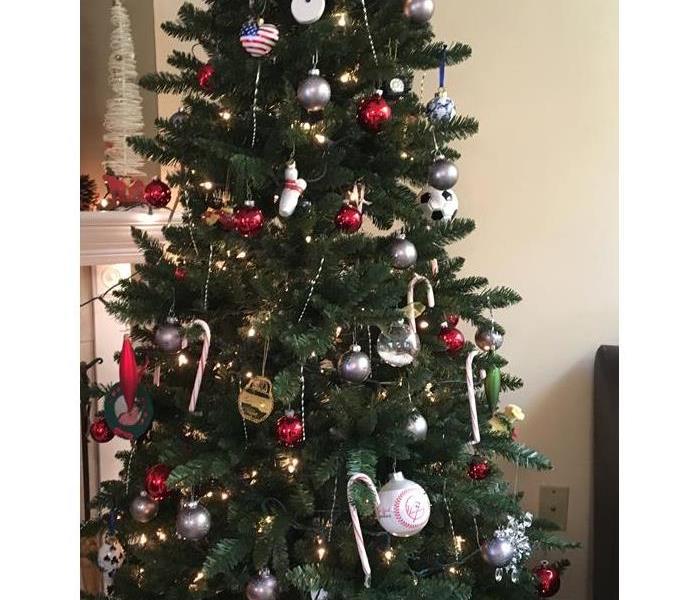 Christmas trees are a wonderful holiday decoration, but it is important to remember to keep them at least 3 ft away from any heat source.
Christmas trees are a wonderful holiday decoration, but it is important to remember to keep them at least 3 ft away from any heat source.
Christmas trees are an integral part of decorating for the holidays. They are beautiful to look at, have that wonderful aroma that permeates the house, and lend a festive atmosphere in the home. But if not properly taken care of and set up correctly, they could pose a dangerous fire hazard.
According to the National Fire Protection Association, the statistics are alarming:
- From 2011-2015, U.S. fire departments responded to an estimated average of 200 home1structure fires per year that began with Christmas trees.
- Christmas tree fires caused an annual average of $14.8 million in direct property damage.
- Four of every five Christmas tree fires occurred in December or January.
- In one-quarter (26%) of the Christmas tree fires, some type of heat source, such as a candle or equipment, was too close to the tree.
With proper planning and common sense, Christmas tree fires can easily be avoided. Here are some tips to remember when bringing home fresh cut trees:
- When choosing a tree, look for one that is fresh and with needles that don’t fall off easily.
- Before placing the tree in the stand, cut 2" from the base of the trunk.
- Make sure the tree is at least three feet away from any heat source, like fireplaces, radiators, candles, heat vents or lights.
- Make sure the tree is not blocking an exit.
- Add water to the tree stand. Be sure to add water daily.
It is important to remember that your holiday lights need to be used safely as well. The lights you use to decorate your tree or your house need to be in good shape:
- Make sure there are no frayed ends or wires showing.
- Make sure the lights are specifically meant for either indoor or outdoor use.
- Replace any string of lights with worn or broken cords or loose bulb connections. Read manufacturer's instructions for number of light strands to connect.
- Never use lit candles to decorate the tree.
- Always turn off Christmas tree lights before leaving home or going to bed.
We at SERVPRO of Eatontown/Long Branch hope all our friends, family and customers have a very happy, healthy and SAFE holiday season!
Holiday Safety Tips
11/20/2017 (Permalink)
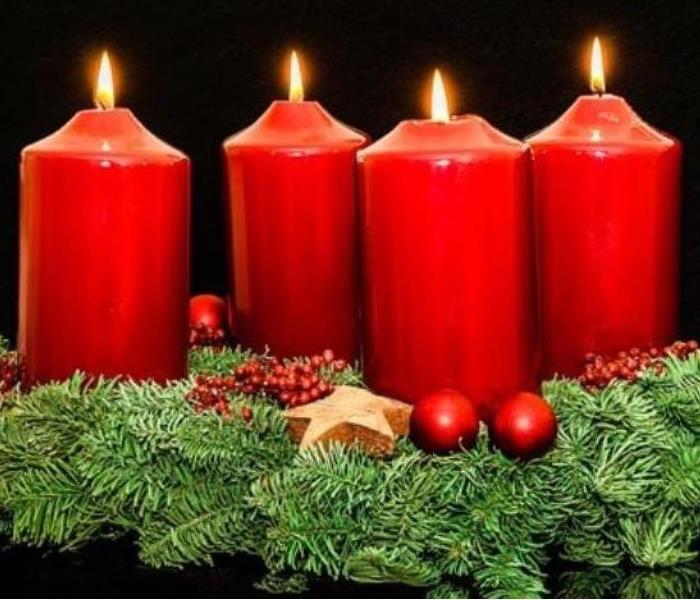 Lit candles are beautiful, but be careful about where you place them. Keep them away from flammable materials and out of reach of children and pets.
Lit candles are beautiful, but be careful about where you place them. Keep them away from flammable materials and out of reach of children and pets.
It’s that time of year - the holiday season- when most people are busy getting their homes ready for large family dinners, guests and celebrations.
With all that goes behind getting your house in perfect holiday order, it’s easy to get distracted and forget about safety.
Here are some tips to remember while you decorate and cook that perfect holiday meal!
Fires
Cooking is the No. 1 home fire hazard, according to the NFPA.
- Always stay in the kitchen when cooking, and always keep an eye on the stove, oven or grill.
- Be careful of smoking oil – that is a sign that the oil is too hot and may ignite. Lower the flame or remove the pan from the heat.
- Never try to put out a pan fire with water. Baking soda works to extinguish a pan fire.
- It is now New Jersey law that every home must have a fire extinguisher within 10 feet of the kitchen area,
- Keep oven mitts, dish towels and other flammable items away from heating elements and open flames.
Candles are a popular decoration, however it is important to follow these simple rules:
- Keep an eye on candles, and never place them near fabrics such as curtains, wall hangings or flammable decorations.
- If you have small children or a pet, make sure the candles are placed out of reach.
- Be sure to extinguish candles before going to bed or leaving the house.
Fireplaces are also a safety concern:
- Have your chimney cleaned annually.
- After a fire, dispose of ashes in a metal container, away from flammable material.
- Keep children at least three feet away from fireplaces.
Lighting
Holiday lighting poses the risk of overdrawing power and creating a fire hazard, and older strands are more likely to overheat because they require more electricity.
- Inspect your lights before hanging them. If they look worn (frayed wires, loose or cracked bulbs), don’t hesitate to replace them. Switch to LEDs, which are more energy-efficient and burn coolerthan conventional incandescents.
- If you’re stringing lights outside, make sure they are for outdoor use.
- Do not attach more than three strings of lights together.
- Always unplug your lights and decorations before going to bed or leaving the house.
Christmas trees
We wish the best, brightest and safest holiday season for all our SERVPRO friends and families.
Is Your House Safe?
10/24/2017 (Permalink)
 Basement wall where dryer caught fire.
Basement wall where dryer caught fire.
How safe is your home? Have you done the proper maintenance needed to minimize your family’s risk of fires? Now is the time for you to prepare your home against risks that are easily avoidable.
According to the National Fire Protection Association, 2015 saw nearly 370,000 home fires nationwide, at a cost of 7 billion dollars in damages. Ninety-two percent of the appliance fires were caused by the clothes dryer. Thirty-two percent of those fires were due to lack of cleaning.
Here are some dryer safety tips:
- Have your dryer installed and serviced by a professional.
- Do not use the dryer without a lint filter.
- Make sure you clean the lint filter before or after each load of laundry. Remove lint that has collected around the drum.
- Rigid or flexible metal venting material should be used to sustain proper air flow and drying time.
- Make sure the air exhaust vent pipe is not restricted and the outdoor vent flap will open when the dryer is operating. Once a year, or more often if you notice that it is taking longer than normal for your clothes to dry, clean lint out of the vent pipe or have a dryer lint removal service do it for you.
- Keep dryers in good working order. Gas dryers should be inspected by a professional to make sure that the gas line and connection are intact and free of leaks.
- Make sure the right plug and outlet are used and that the machine is connected properly.
- Follow the manufacturer’s operating instructions and don’t overload your dryer.
- Turn the dryer off if you leave home or when you go to bed.
As scary as the statistics for dryer fires sound, they aren't close to being the number one cause of home fires. Two out of every five home fires started in the kitchen, Cooking and cooking equipment account for over 60% of all home fires. They also account for 42% of all fire related injuries in the home.
The peak month of the year for these kitchen related fires is January, the peak time being between 5-8 p.m. Unattended cooking was by far the leading cause of these fires.
What you need to know:
- Be on alert! If you are sleepy or have consumed alcohol don’t use the stove or stovetop.
- Stay in the kitchen while you are frying, grilling, boiling or broiling food.
- If you are simmering, baking or roasting food, check it regularly, remain in the kitchen while food is cooking, and use a timer to remind you that you are cooking.
- Keep anything that can catch fire — oven mitts, wooden utensils, food packaging, towels or curtains — away from your stovetop.
It all amounts to common sense and being mindful.
This short video has more safety information:
https://www.youtube.com/watch?v=Dm6UMPP2z8I
3 Alarm Fire In Destroys Businesses And Homes in Ocean Grove
2/9/2015 (Permalink)
 Green on the scene Saturday morning in Ocean Grove.
Green on the scene Saturday morning in Ocean Grove.
A three-alarm blaze demolished a section of Main Street in Ocean Grove on Friday. The fire began in an apartment above Yvonne's Luncheonette at approximately 4pm. Firefighters battled the flames and cold temperatures throughout the night.
On Saturday morning, SERVPRO of Eatontown/Long Branch was called in to clean up the soot, smoke and water damage in three adjacent buildings. Crews began work shortly before noon. SERVPRO of Eatontown/Long Branch offers 24 hour response for fire, and water clean up and remediation.
At this point, no cause has been determined for the fire.





 24/7 Emergency Service
24/7 Emergency Service















